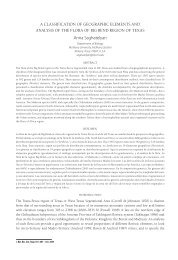George Poinar Jr. Kenton L. Chambers Ron Buckley
George Poinar Jr. Kenton L. Chambers Ron Buckley
George Poinar Jr. Kenton L. Chambers Ron Buckley
You also want an ePaper? Increase the reach of your titles
YUMPU automatically turns print PDFs into web optimized ePapers that Google loves.
92 Journal of the Botanical Research Institute of Texas 1(1)<br />
materials and methods<br />
The flower is complete and well-preserved. One of the petals shows some evidence of insect damage, and<br />
fungal hyphae are associated with one of the anthers. The flower was in anthesis at entombment, and pollen<br />
grains occur on and adjacent to the anthers as well as on the stigma. The piece of amber containing the flower<br />
is square, measuring 5 mm in length by 5 mm in width by 1.5 mm deep. Examination and photographs were<br />
made with a Nikon stereoscopic microscope SMZ-10 R at 80 × and a Nikon Optiphot microscope at 800×.<br />
description<br />
Eoëpigynia <strong>Poinar</strong>, <strong>Chambers</strong> & <strong>Buckley</strong>, gen. nov. type species: Eoëpigynia burmensis <strong>Poinar</strong>, <strong>Chambers</strong> & <strong>Buckley</strong>, sp. nov.<br />
Diagnosis.—Flowers small, bisexual, regular, epigynous; perianth tetramerous; calyx comprising a short<br />
crown (gamosepalous) at summit of ovary, sepal lobes incised, number uncertain; petals 4, separate, valvate,<br />
regular; stamens 4, free to base, in a single whorl, alternating with the petals, filaments linear, anthers introse,<br />
dorsifixed; pollen shed singly, pollen grains triaperturate (possibly tricolporate with thickened exine<br />
adjacent to colpi); gynoecium syncarpous, ovary inferior, style 1, stigma bilobed, pericarp wall thick-textured<br />
at anthesis, fruit type unknown; presence of floral disc not determinable.<br />
Eoëpigynia burmensis <strong>Poinar</strong>, <strong>Chambers</strong> & <strong>Buckley</strong>, sp. nov. (Figs. 1–2). type: myanmar (burma): kachin: northern<br />
Myanmar, amber mine in the Hukawng Valley, SW of Maingkhwan, (26º20´N, 96º36´E), Aug 2005, <strong>Buckley</strong> s.n. (holotype: perfect<br />
flower (accession # ab 214) deposited in the collection of <strong>Ron</strong> <strong>Buckley</strong>, Florence, Kentucky 41042-8355, U.S.A.).<br />
Description.—Flower bisexual, glabrous, length 1.5 mm; no free hypanthium evident; calyx lobes with<br />
incised margins, greatest length of calyx 0.34 mm; petals lanceolate-ovate, margins abaxially recurved, up<br />
to 0.95 mm long, 0.34 mm wide; stamens with ovoid anthers up to 0.15 mm long, filaments 0.54–0.61 mm<br />
long; stigma at level of anthers, estimated length of style 0.55 mm; length of ovary 0.54 mm; width of ovary<br />
0.39 mm; diameter of pollen grains, 12–14 µm.<br />
Etymology.—Genus name from the Greek “eos” dawn, “epi-“ upon, and “gyne” female, from the age and<br />
the relation of the floral perianth to the ovary. Species named for the country of origin of the fossil.<br />
discussion<br />
Certain structures that would be helpful in the placement of Eoëpigynia, for example the presence of a floral<br />
disc, could not be observed due to the fossil’s orientation in the amber. However, it was possible to view the<br />
flower from both sides to verify the characteristics described here. Based on its floral features, Eoëpigynia<br />
(Figs. 1, 2) represents a core eudicot that can provisionally be assigned to the family Cornaceae sensu lato,<br />
in the basal asterid order Cornales. The phylogenetic position of Cornales as sister to all the remaining<br />
asterids (perhaps excluding Ericales) is well confirmed by molecular studies (Stevens 2001 onwards; Hilu<br />
et al. 2003; Judd & Olmstead 2004; Bremer et al. 2004). The perfect flower, inferior ovary, compound style,<br />
4-merous perianth and androecium, and possibly tricolporate pollen of our fossil are most similar to the<br />
modern genus Cornus (see illustrations in Wangerin 1910; Judd et al. 1999). The pollen of the fossil may be<br />
of particular importance in this placement. In an equatorial optical section (Fig. 1D) three distinct paired<br />
thickenings are seen in the exine marking what we assume are the three colpi (we could not focus our instrument<br />
clearly on a pore at this spot). This pattern is strongly reminiscent of SEM equatorial transections<br />
of Cornus pollen illustrated by Ferguson (1977), e.g. his figure 2c of thickened endexine in this area in C.<br />
volkensii, as well as his figures 4d of C. disciflora and 6c of Curtisia dentata. Because of the pollen orientation<br />
in the amber, we were unable to observe a pore face-on, where the characteristic H-shaped endoaperture<br />
thinning pattern of Cornaceae/Nyssaceae might be seen (Erdtman 1966; Ferguson 1977). The pollen grains<br />
of Eoëpigynia are smaller than in most of the types defined by Ferguson (1977) but are within the range of<br />
his Curtisia-type, described as 12–20 × 12–17 μm (p. 6). One might speculate that small pollen are related<br />
adaptively to the small size of pollinating insects of that period, for example the 2 mm-long bee recently<br />
described from Burmese amber by <strong>Poinar</strong> and Danforth (2006).



